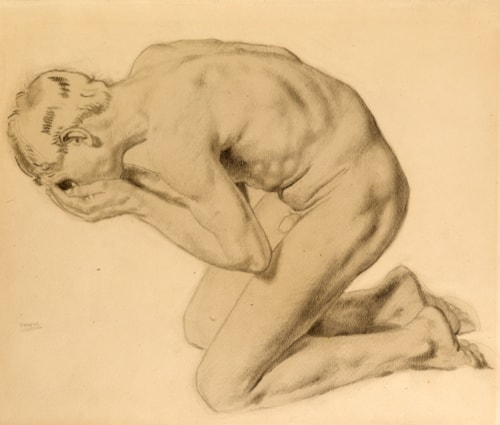
William ORPEN
Stillorgan 1878 - London 1931
Biography
William Orpen showed a talent for art at an early age, and in 1891 was admitted into the Metropolitan School of Art in Dublin. He soon came to the attention of his teachers and contemporaries as an immensely gifted draughtsman, and won several prizes for his drawings. In 1898, he transferred to the Slade School of Art in London, where his drawings continued to impress all who saw them. At the Slade, where his professors included Philip Wilson Steer and Henry Tonks, he met and befriended Augustus John. The two young artists soon came to dominate their class at the school, where they were quickly recognized as head and shoulders above their fellow students in terms of talent. Orpen joined the New English Art Club, and exhibited at the Royal Academy and the Royal Hibernian Academy. He was appointed an Official War Artist in 1917, and his powerful paintings and drawings of the trenches in France were exhibited in London the following year. Knighted in 1918, Orpen later published more of his scenes of the war in An Onlooker in France, 1917-1919, which appeared in 1921. The 1920’s found the artist at the height of his success, firmly established as one of the leading portrait painters in England, with a fashionable clientele and no shortage of commissions. Yet after his death at the age of only fifty-two his reputation lapsed into obscurity, and it has not been until relatively recently that he has regained something of the stature he once enjoyed.
Throughout his career, William Orpen was admired as one of the finest draughtsmen of his day. He drew for long hours every day, and left behind a large corpus of drawings and sketches. As the critic of The Art News commented of a publication of a portfolio of ten photogravure reproductions of his drawings in 1915, ‘These drawings are remarkable not only for their delicacy of handling, but for the loving care with which the pencil has revelled in beauty of form. Mr. William Orpen is thoroughly modern, yet he continues a tradition which has been handed down from the great draughtsmen of the past. His work does not suffer when placed by the side of the work of the Old Masters, a supreme but dangerous test.’
Another critic, writing at the same time in The Ladies’ Field, noted that ‘Mr. Orpen may be described as a tender draughtsman, tender in his care of and love for his materials. His hand is so marvellously delicate. His pencil hovers over the paper with the grace of a butterfly…He does not strive for the beauty of feature, as the French draughtsmen of the eighteenth century tried to capture those qualities. At times he is almost ugly and brutal; but he never loses the beauty of form.’







